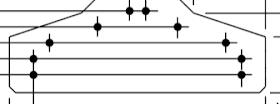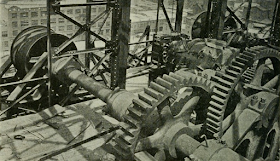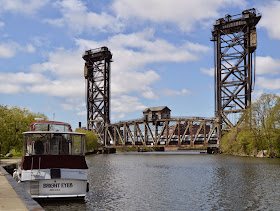I put "railfanning" in quotes for a few reasons. One is that I no longer have been setting by the rail side waiting for trains. I've just been taking pictures of what I see when I do trips to downtown. But since I cross the CB&Q 3-track "racetrack" when I go downtown, I do see some trains. Two is that I'm learning that real railfanning seems to be taking publishable photos of the leading engine. I take photos for information. That means that I'll spend electrons on all of the engines and even some of the freight cars. Even if the sun is behind a cloud or I'm on the dark side of the train. I don't plan to publish, that is why my profile specifies a Copyleft. If a web picture is good enough for a student report, then go for it with proper acknowledgement. Three is particular to this post---I ran out of sun. So the photos are really bad even by my standards. So bad that I have to rely on my memory instead of the photos as to what I saw. Having to rely on my memory is why I have to quickly write a post for this set of pictures. (I'm still behind on three other days of train photos.)

19:20 On my way to downtown (Downers Grove), when I got to the crossing of Main and Warren, a westbound covered-hopper unit train came through. When I saw that it was CSX power I took some grab shots in hope that I could catch the engine numbers. I also believe that the first unit has an older paint scheme and the second one has the current "boxcar" scheme.
The units were 688 and 4049. And we learn from
The Diesel Shop that 668 is an AC6000CW (Powered by 16-cylinder 6000-hp GEVO engine) and 4049 is a SD40-3 (ex CSXT 8081). Since AC6000CW is a unit that was built during the horsepower race between EMD and GE, it is rather special so I'll include my other grab shot of it.
 |
| 20140826 0025c |
|
|
|
(Thank goodness that bike rider's hat was not in front of the number in the first picture.) I grabbed pictures of the SanteFe hoppers until I realized there were quite a few of them. I would estimate that about a third were SanteFe, a half were BNSF, and a sixth were "other."
19:49 Catching the engines of trains has been harder this Summer because there continue to be false gate closings for a few minutes. Before this Summer, when I heard the bells start ringing, I would find the clearest shot I could find down the street and hold the camera to my face. Not this Summer. But on my way back home, it was not a false gate closing. It was a westbound mixed freight. I did grab the second unit, which indicated this was another CSX run through.

As usual, the dominate freight cars were covered hoppers and tank cars. There were a few empty lumber cards. But there was one full one. It is unusual to see lumber heading towards the west. I wonder where it was coming from. I took a picture of that car more as a test of the camera handling the lack of light because the sun was getting low than of the car itself. This train was taken with the camera ISO cranked up to 800. 400 has become my normal setting. Next time I see a train at dark, I'll try different freight cars with different ISO settings. The dark lighting experiment had results. It caused me the Read The Fine Manual again concerning ISO. I now understand the difference between Auto and Programmed mode----auto ISO setting. I switched the camera from Programmed to Auto unless I'm doing the above described freight car ISO experiment. I want to learn what the digital noise looks like. I already know what a grainy photo looks like.

Boxcars of all sizes are getting rare because of TOFC and container trains. So I took a picture when I saw that there were two extra-high boxcars in a row. The sun is getting lower, and I got an unintended "speed blur."

19:59 And then when I was about a block past the tracks, the gates went down again. Since I knew a westbound commuter was coming into the station and since they cause the false gate closings, I didn't pay much attention. But then I heard the sounds of a freight train. When I turned around and looked, two light-yellow engines rolled eastbound. I can't even guess what railroad uses light-yellow engines. I couldn't see the train very well, but I could see that it was another mixed freight. I took a picture, again as an experiment with the light because the sun was pretty much gone by now. If I zoom in, you can tell it is a boxcar and that confirms that it was a mixed freight.

And then I saw what looked like vehicle cars. But that did not make sense because they are always in unit trains or with container/tofc trains. And I've never seen them on this line. Just the old SanteFe line. So I took a picture. Sure enough, they are not vehicle cars. I guess it is a load on a flat car. What the load is will remain a mystery forever.

Just when I thought I had the camera figured out, I used Windows Photo Viewer to check the ISO values. Since I thought I was done for the night, I had set the camera back to ISO-400 so that the next day I was not inadvertently shooting with 800. Those for the second train's box cars is what I expected---ISO-800, f/3.5, 1/40 sec. But the above picture was a surprise---ISO-5000, f/5.6, 1/100 sec. I noticed at the time I took the picture that the shutter speed was a lot faster than I had expected. When I checked the camera again, I did notice that I had changed the ISO to Auto. So when the light is very low, even Programmed mode will do Auto ISO if you allow it. In previous weeks when I did not have ISO set to Auto and was using the default ISO-100, I can confirm that it will use a shutter speed that is so slow you can hear the click-click even with decent looking light.
So of the three freight trains I saw, none had engines painted with Omaha Orange. And two of them were mixed freights.









































































































 :-) The train took a slightly different route to Union Station. Rather than crossing the Chicago River on the Saint Charles Air Line Bridge, the train passed by some lovely parks and crossed the river on the Canal Street bridge (I hope that's what it's called). When we left on Wednesday's Illini, we crossed the river on the St. Charles Air Line, which is normal.
:-) The train took a slightly different route to Union Station. Rather than crossing the Chicago River on the Saint Charles Air Line Bridge, the train passed by some lovely parks and crossed the river on the Canal Street bridge (I hope that's what it's called). When we left on Wednesday's Illini, we crossed the river on the St. Charles Air Line, which is normal.












.jpg)
.jpg)